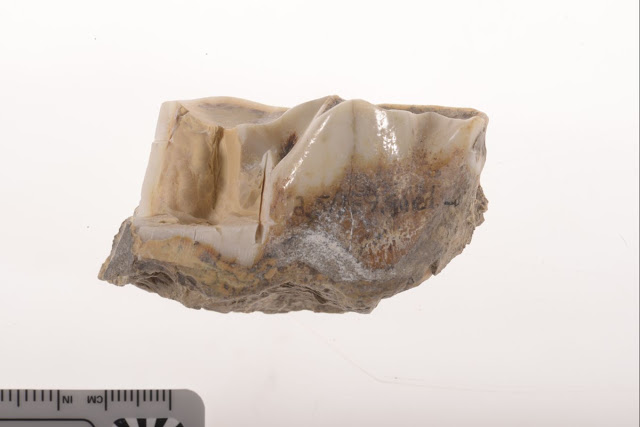11/09/2019
Genetic data from 1.7 million years ago identified, the oldest recorded to date
The journal Nature has reported the finding of a rhinoceros tooth at the site in Dmanisi, Georgia, where members of IPHES and the URV are working

The journal Nature has reported the finding of a rhinoceros tooth at the site in Dmanisi, Georgia, where members of IPHES and the URV are working
A recent finding has paved the way to a revolution in the study of evolution after an international team working in Dmanisi (Georgia) has acquired genetic data from a 1.7-million-year-old rhinoceros tooth, the oldest to have been identified to date. The data acquired is a full set of proteins – a proteome – identified in the animal’s dental enamel and is 1 million years older than the oldest DNA sequenced from a horse and which dates back 700,000 years.
The finding was announced in an article published in the journal Nature, which was authored by leading scientists from the University of Copenhagen and Saint John’s College (University of Cambridge). However, the project also counted on the participation of 48 other researchers, two of whom were ICREA (Catalan Institute of Research and Advanced Studies) researchers from IPHES (Catalan Institute of Human Palaeoecology and Social Evolution) and the URV (Universitat Rovira i Virgili): Bienvenido Martínez-Navarro, who studies the large carnivores at Dmanisi (bears, hyenas and sabre-toothed tigers), and Jordi Agustí, who analyses the small mammals from the same site, which has become one of the main sources of information on the first humans.
The finding reported in Nature is a major advance in the field of biomolecular studies into ancient fossil remains and may provide an answer to some of the mysteries of animal and human biology, enabling scientists to accurately reconstruct evolution over time, now from much further back in the past.

In the last 20 years, ancient DNA has been used to tackle a variety of questions about the evolution of extinct species, adaptation and human migration, but it has its limits. The new genetic information will make it possible to reconstruct molecular evolution beyond the habitual time limits of the preservation of DNA, so the analysis of ancient protein from dental enamel is the start of an exciting new chapter in the analysis of molecular evolution, as the scientists participating in the study have been quick to point out.
The DNA data that genetically track human evolution only cover the last 400,000 years. But the lineages that led to modern humans and chimpanzees – the living species that is genetically closest to humans – separated some 6 or 7 million years ago, which means that the scientific community currently has no genetic information for 90% of the evolutionary path that has led to modern humans.
Neither does the scientific community know how we are genetically linked to extinct species such as Homo erectus – the oldest species known of the genus Homo with human body proportions similar to those of Homo sapiens. Everything known about Homo erectus at the moment is almost exclusively based on anatomic, not genetic, information.
The researchers used ancient sequencing technology (based on the innovative technology known as mass spectrometry) to retrieve genetic information from the tooth of a 1.7-million-year-old Stephanorhinus, an extinct species of rhinoceros that lived throughout Mediterranean Europe and in western Asia. They managed to sequence the ancient protein and retrieved genetic information that had been impossible to obtain with DNA sequencing.
Mass spectrometry
Tooth enamel is extremely hard, abundant and long-lasting. It is found in mammals and provides more genetic information than collagen, the only other protein that has been retrieved from fossils more than a million years old. As a result, applying mass spectrometry to this material opens up a wide range of possibilities for a more advanced evolutionary study in both humans and mammals, and it will revolutionise research methods based on molecular markers.
Molecular phylogenetic analyses show that the Stephanorhinus rhinoceros comes from a group related to the woolly rhinoceros (Coelodonta antiquitatis). This shows that Coelodonta evolved from a primitive representative of Stephanorhinus which, therefore, has at least two evolutionary lines.
This rearrangement of the evolutionary lineage of a single species may seem like a mere small adjustment, but the identification of changes in numerous extinct mammals and humans may lead to a new understanding of how the world has evolved. The discovery may enable scientists from all over the world to collect genetic data from ancient fossils and construct a larger, more accurate picture of the evolution of hundreds of species, including our own.
Bibliographic reference. Cappellini et al., “Early Pleistocene enamel proteome from Dmanisi resolves Stephanorhinus phylogeny”, Nature (2019)
